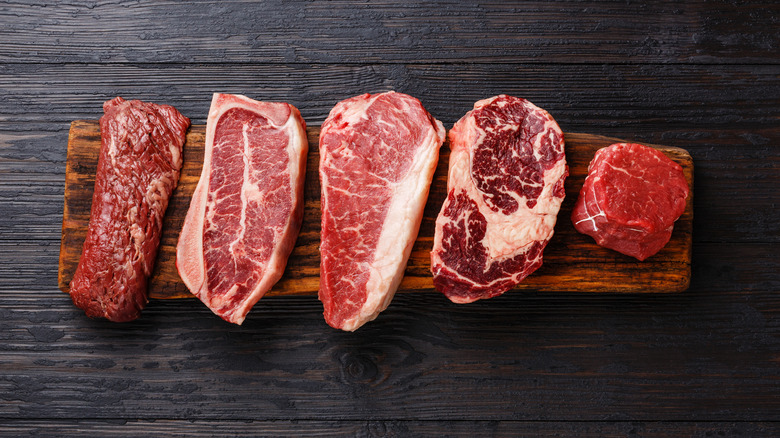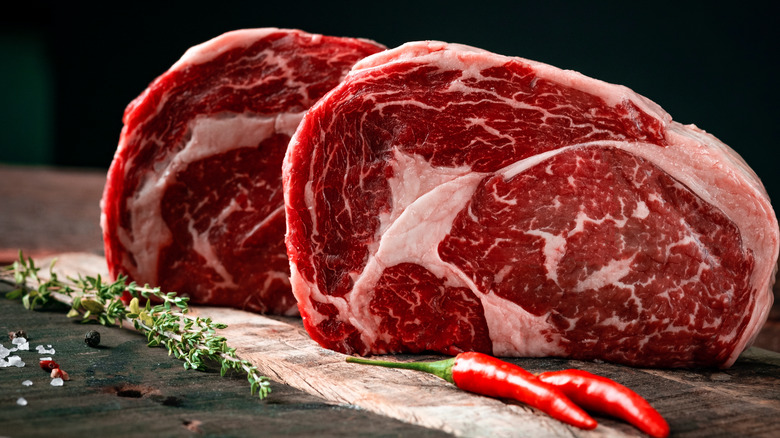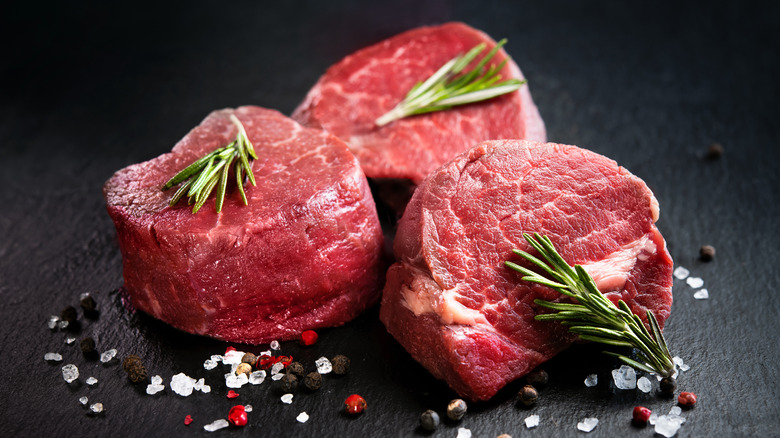Ribeye Steak Vs. Filet Mignon: Is There A Nutritional Difference?
From chuck roast, short ribs, and ribeye to T-bone, tri-tip, and filet mignon, there are tons of different beef cuts and steak options (per Certified Angus Beef). A cow is divided into nine different cut sections: round, sirloin, short loin, rib, chuck, flank, plate, brisket, and shank. Steak Revolution ranks the best cuts of steak as ribeye being first and filet mignon coming in second.
There are a lot of differences between filet mignon and ribeye steak. According to Certified Angus Beef, ribeye steak comes from the rib section, while filet mignon comes from the short loin section. Filet mignon is a lot more tender than ribeye since it comes from near a cow's ribcage, which isn't heavily exercised. Ribeye is also a tender cut, but it has more fat or marbling than filet mignon. Ribeye comes from a muscle that spans from a cow's shoulder to its hip (via Smoked BBQ Source). Let's take a look at the nutritional differences between the two cuts.
Nutritional profile of ribeye steak
A three-ounce serving of ribeye has about 248 calories, 68 milligrams of cholesterol, 46 milligrams of sodium, 20 grams of protein, 8 grams of saturated fat, 3 grams of trans fat, and 9 grams of polyunsaturated and monounsaturated fats (per Chicago Steak Company). However, it's important to note that most restaurants don't serve just three ounces of steak. Popular U.S. steakhouse Ruth's Chris offers a 16-ounce ribeye, which is a little over five times the suggested serving size.
Cholesterol, fat, and sodium are a few things to look out for when eating ribeye, as high levels can affect your heart and blood pressure. If those aspects are of concern, you can choose a piece of ribeye that has little to no fat marbling and cook it for longer so more of the fat melts off. But ribeye is a great source of protein and has some healthy fats, such as polyunsaturated and monounsaturated fats, as well as 221 milligrams of potassium per three-ounce serving (via Chicago Steak Company). Potassium may help regulate sodium and blood pressure levels. Here's how to cook the perfect ribeye steak.
Nutritional profile of filet mignon
A three-ounce serving of filet mignon has around 227 calories, 82 milligrams of cholesterol, 46 milligrams of sodium, 22 grams of protein, 6 grams of saturated fat, 0 grams of trans fat, and 0 grams of polyunsaturated and monounsaturated fats (via Chicago Steak Company). As mentioned above, a majority of restaurants serve filet mignon that is way more than the recommended serving of three ounces, and for example, Ruth's Chris offers an 11-ounce filet mignon — that's almost four times more than the recommended serving.
Filet mignon has similar sodium levels to ribeye, but the former has higher cholesterol and less fat levels than the latter. Filet mignon also has 280 milligrams of potassium, is a great protein source, and contains iron, zinc, and vitamins B-6 and B-12. The bottom line is as long as you stick to healthy, three-ounce portions of either filet mignon or ribeye, both cuts of meat are great options. Here are some tricks for cooking a perfect filet mignon every single time.


